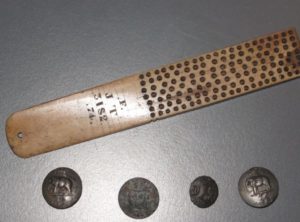HMS Birkenhead

1852
“Not all deeds of glory, valour and steadfastness take place on the field of battle”.
HMS Birkenhead, carrying reinforcements for the Kaffir War in South Africa, struck rocks off the coast of Simonstown and sank 25 minutes later. It is the first recorded incident of “Women & Children First” or The Birkenhead Drill.
Colonel Seton, ordered his men of The 74th Highlanders and other regiments to stand fast so that the women & children could use the available boats – out of a company of 631 on board the ship, only 193 (including all the women & children) were saved.
Starting life as HMS Vulcan in 1846, this frigate was renamed HMS Birkenhead and after several changes of use, was converted into a troop ship in 1851. In January 1852, HMS Birkenhead left Portsmouth conveying troops from The 74th Highlanders (the largest draft) and nine other regiments; collecting more soldiers, officers’ wives and families from Ireland, to sail to the Kaffir Wars in South Africa.
On 23 February 1852, Birkenhead docked briefly at Simonstown, near Cape Town, where most of the women and children, along with some sick soldiers, disembarked. They were replaced by 9 cavalry horses, several bales of hay and 35 towns of coal for the last part of the voyage to Algoa Bay.
The exact numbers on board are in doubt, but it is thought that there were 630-43 men including crew, plus about 26 women and children. Lieutenant Colonel Seton was the Officer Commanding Troops – he had been appointed to command of The 74th Highlanders in place of Lieutenant Colonel Fordyce who had been killed in action.
Around 2 am on 26 February, the ship struck an uncharted rock near Danger Point and the sea rushed in the large hole to drown over 100 of the soldiers who were asleep in their hammocks. The other soldiers rushed onto the deck and were immediately set to work manning the pumps and launching the boats, while the women and children were placed in the ship’s cutter, which lay alongside. Only three of the smaller boats were sea-worthy and were launched – the remaining soldiers were told to stand firm on deck, lest by jumping overboard they would rush the boats and risk swamping them, endangering the lives of the women and children. Although the cavalry horses were freed and allowed to swim towards the shore.
The soldiers did not move even when the ship broke up, barely 20 minutes after striking the rock and a survivor later remarked: “Almost everybody kept silent, indeed nothing was heard, but the kicking of the horses and the orders of Salmond (the Captain), all given in a clear firm voice.”
Some of the soldiers managed to hang on to wreckage and other managed to swim the 2 miles (3.2 kilometres) to shore, but most drowned, were taken by sharks or died of exposure. Ensign Russell of The 74th Highlanders gave up his seat in one of the boats for a soldiers and was immediately taken by sharks. There were only 193 survivors, including 119 soldiers, but all the women and children were saved. Eight of the horses made it to shore, sadly the ninth broke its leg when it was pushed into the sea.
The wreck lies in 30 metres of water and many items have been retrieved, some of which are in the Museum collection. Despite being designated a war grave, the wreck is much disturbed by treasure-hunters hunting for the rumoured military payroll of £250,000 in 120 boxes of gold and silver coins, which was said to be in the hold!
News of this incident spread around the world: the story, an example of supreme discipline and self-sacrifice, was read aloud to every regiment in the Prussian Army.
A memorial in St Giles Cathedral in Edinburgh reads: “In memory of Lieut.-Colonel Alexander Seton, Ensign Alex. C. Russell, and forty-eight N.C.O.s and men of the 74th Highlanders who were drowned at the wreck of H.M.S. ‘Birkenhead’ on the 26th February 1852, off Point Danger, Cape of Good Hope, after all the women and children on board had been safely landed in the ship’s boats.”
The Birkenhead has secured a place in history due to the gallantry of her men, who, in the face of great danger, allowed the women and children to escape in the boats before trying to save themselves and so establishing “The Birkenhead Drill” – the great naval tradition of “Women & Children First”.
Rudyard Kipling’s lines say it all:
‘To stand and be still
to the Birken’ead Drill
is a damn tough bullet to chew’.
